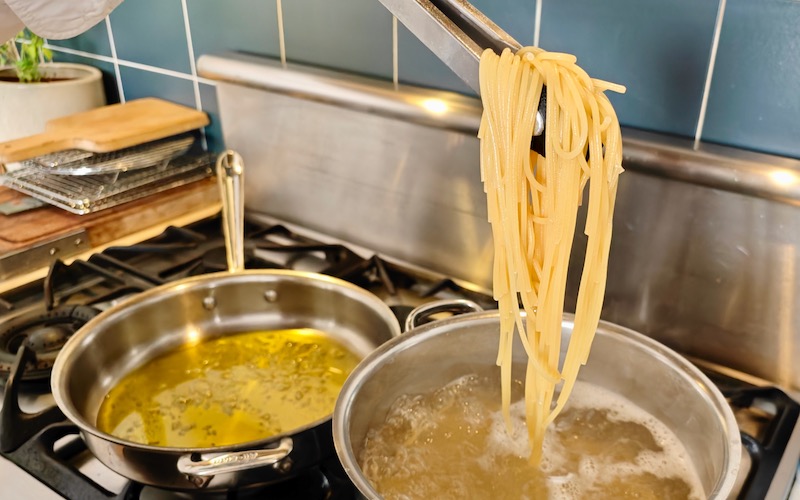

Pasta comes in two basic forms: dried and fresh. Both are good, but suitable for different sauces.
Fresh pasta, typical of more affluent northern Italy, usually contains egg. It’s most often served with rich meat ragùs and creamy or buttery sauces.
Some fresh pasta – such as Sardinian lombrichi and cicciones – is made without egg.
Gnocchi is another form of fresh pasta.
Dried pasta is typical of poorer southern Italy. It’s made from just flour and water and best dressed with olive oil, tomato and bolder Mediterranean flavours.
If you’re buying dried pasta, Italian is best! Dried pasta should be made from a particularly hard variety of wheat called durum wheat, any other variety creates a pasta that’s too soft when cooked. Under Italian law dried pasta can only be made with durum wheat.
The best dried pasta is extruded through bronze dies rather than the more commercial Teflon-coated ones. Bronze leaves a rougher, more porous surface for the sauce to cling to. This pasta is also called bronze-extruded or bronze-drawn pasta.
To cook pasta like a Nonna, you’ll need:
Follow these simple rules to cook pasta like an Italian Nonna (scroll down for a step-by-step video):
Now you know to cook pasta like an Nonna, try these delicious pasta recipes.
Share page on:
Pasta comes in two basic forms: dried (more typical of southern Italy) and fresh (often containing egg and more common in the north). They are both good products, suitable for different sauces, here we’re talking about dried pasta.
I buy Australian whenever I can, but when it comes to pasta, Italian is best! Dried pasta should be made from just water and durum wheat (a particularly hard variety of wheat); under Italian law no other wheat variety is allowed. Any other wheat creates a pasta that is too soft when cooked.
The best pasta is extruded through bronze dies rather than the more commercial Teflon-coated ones. This leaves a rougher, more porous texture to give the sauce a better surface to cling to; it’s also called bronze extruded pasta or bronze drawn pasta.
Artisanal means that the pasta is made in relatively small quantities and in a traditional way, for example bronze extruded. There are several good brands available in Australia including Rustichella d’Abruzzo, Giovanni Fabbri and I Due Pastori. Some however are quite temperamental and go from hard to soft very quickly. I find a good commercial pasta such as Barilla reliable for consistent results and a little more forgiving if it’s in the pan for a minute too long.
Always add pasta to plenty of well-salted water that’s been brought to a rolling boil, ideally 1 litre of water and 10-15g of salt for every 100g of pasta. Use the packet timing as a guide, but check by biting a piece regularly during cooking, and cook it until it’s just al dente (literally ‘to the tooth’), meaning it has some resistance or bite to it. It will continue to cook in the heat of the sauce, so be brave and drain it just before you think it’s ready.
Once pasta is cooked, act quickly. Drain it, reserving some of the cooking water, add pasta to the sauce and toss together so that every strand is coated. The pasta cooking water contains starch from the pasta and tossing a little of this through the pasta and sauce gives a creamy consistency and helps bind the sauce and pasta together.
The sauce is meant to dress the pasta and flavour it, not drown it. Non-Italians often serve pasta with a lot more sauce than would ever be served in Italy. If you sauce your pasta correctly, by tossing the freshly cooked pasta through the hot sauce, the pasta will absorb the sauce so that every bite has flavour and you’ll need less sauce.
Risottata, meaning ‘in the style of risotto’, is a traditional way of cooking pasta in the sauce rather than by boiling it first then adding it to the sauce at the end. Some recipes cook the dried pasta directly in the sauce, others par-boil it then finish it off in the sauce. Either way the pasta absorbs flavour from the sauce and is extra delicious.
‘Al dente’ literally translates as ‘to the tooth’, meaning the pasta has some bite, or resistance to the tooth. It is how Italians describe pasta (or risotto) that is perfectly cooked, meaning it is tender but still firm enough to have some resistance when bitten. The term only applies to dried pasta, not fresh which is cooked until tender.








Share page on: